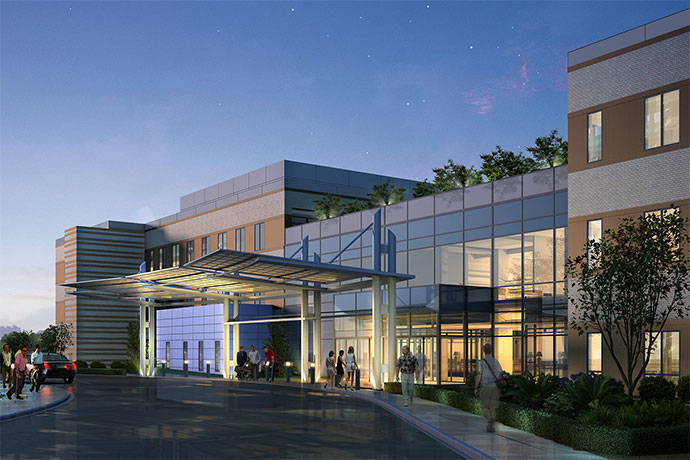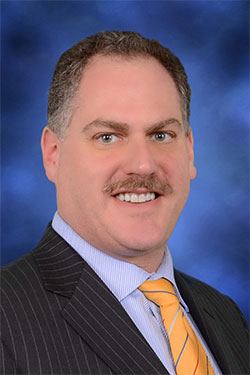Australia’s Lend Lease, one of the world’s largest social infrastructure providers and public-private developers with 16,500 employees worldwide, participated last week in the groundbreaking ceremony for the Department of Veterans Affairs’ (VA) new Healthcare Center in Kernersville, N.C., part of the Greensboro-Winston-Salem-High Point metro area. Lend Lease is currently serving as the project developer, design-builder, and long-term property manager. Completion of the center, which will receive an investment of more than $100 million, is targeted for fall 2015.
The 375,000-gross-sq.-ft. (34,838-sq.-m.), four-story healthcare center will provide primary and mental healthcare to veterans; clinics will include dental, diagnostic, laboratory, cardiology, pulmonary, audiology, ophthalmology, pathology, radiology, and pharmacy. Once operational, the Healthcare Center will serve an estimated 30,000 veterans annually.
It’s part of a wave of VA projects across the country. VA is America’s largest integrated healthcare system with over 1,700 sites of care, serving 8.76 million veterans each year.
“My colleagues and I take great pride and are honored to be part of the creation of a healing place for our veterans, a place that will provide vital services long after their service to our nation is complete,” said Gary Buechler, managing director and president, Lend Lease Americas.
Lend Lease is a worldwide leader in the creation of healthcare facilities ranging from the $2.2-billion Royal Children’s Hospital in Australia, to the $700-million Queens Hospital in the UK. In the Americas region, where it employs 160 in the healthcare sector alone, Lend Lease has developed and acquired more than 5.4 million sq. ft. (501,660 sq. m.) of healthcare real estate. The company has completed over 1,500 healthcare projects in the Americas, valued at more than $15.5 billion, and has managed more than 85 million sq. ft. (7.9 million sq. m.) of healthcare-dedicated construction projects. In the US alone, Lend Lease has completed healthcare projects in 42 states and the District of Columbia.
The Kernersville facility is designed to obtain LEED-Gold status upon project completion. In an email exchange, Gary Buechler, formerly a partner specializing in real estate law at international law firm Kelley Drye & Warren, wrote, “What we have done on the VA Healthcare Center in Kernersville is incorporate a holistic approach to sustainability into the design of the center, such as the use of natural light throughout the center to promote healing and a connection to the outdoors. One of the many sustainable features is the green roof that will allow veterans to utilize the outdoor space and provide an inviting place for veterans to socialize between appointments. In addition, we are providing a pond to serve as the centerpiece for a physical rehabilitation activity pathway on the grounds.”
Buechler said this “is the first VA project where Lend Lease is serving as the developer, builder and property manager. We are looking for future opportunities to work with the VA.”
Below is an edited transcript of the conversation.
Site Selection: How are this and other healthcare/life sciences projects on the Lend Lease docket functioning as economic development catalysts in their respective locations?
Gary Buechler: Wherever Lend Lease operates, our priority is to work with the local community and work with local subcontractors. For the VA Healthcare Center in Kernersville we anticipate that the project will create over 1,000 construction jobs throughout the duration of the project and at the peak of construction we should have over 400 construction workers on site daily. Upon completion, the VA Healthcare Center will support approximately 500 permanent jobs providing an additional economic stimulus to the surrounding communities.
SS: Compare and contrast how project execution and management with the VA and other US agencies unfolds compared to public-sector healthcare projects Lend Lease is overseeing in other nations such as the UK and Australia.
GB: Even though there are many potential opportunities for public-private partnerships (PPP), the U.S. still has a lot of work to do on establishing clear policies for project execution and management compared to Australia.
The use of PPP in Australia has evolved considerably since its early use in the 1980s and is now used to deliver services across a very wide range of sectors of economic (roads, rail, airports, etc.) and social infrastructure (schools, hospitals and prisons, etc.). The Australian market now has a reputation for a transparent procurement process, which is being used to deliver infrastructure projects across a plethora of sectors. The widespread use of PPP across Australia is now being facilitated with a National PPP policy and guidelines developed by Infrastructure Australia on behalf of the federal government. Below are examples of policies in Australia that the U.S. could implement to grow PPP opportunities.
- A legislative framework that permits private sector ownership, management and operation of public infrastructure across a wide range of infrastructure assets;
- A transparent procurement process for large-scale infrastructure projects;
- A dedicated federal minister for infrastructure with a centrally coordinated set of project and policy guidelines overseen by Infrastructure Australia;
- A well supported network of PPP departments and infrastructure ministers across the states and territories with well understood procurement methodology and policy guidance;
- A deep market participation by a wide range of foreign and domestic financial investors, contractors, facilities maintenance providers and institutional equity providers;
- An accounting and tax regime that is well understood and facilitates long term equity investment in infrastructure.

SS: In more general terms globally, we have reported quite a bit on the convergence of healthcare workspace with biopharma and other life sciences workspace from corporates, as well as university science parks. Are you seeing this convergence in the design and location of facilities worldwide?
GB: In the life Science/biopharma sector, yes, we are seeing a number of examples where biopharma and other research or academic uses are combined with clinical services and other more traditional healthcare uses. In addition, there is a strong trend in the biopharma/life science industry globally to change the nature of their real estate assets by modernizing them, making them more productive and more sustainable. By implementing these changes, companies have seen increased employee productivity and a decrease in the amount of time taken off to do illness. In addition, companies have a seen dramatic reduction in energy costs in their real estate portfolios after they have invested in sustainable retrofits.
In healthcare, many services such as urgent care, primary care, health education, preventive medicine, and wellness centers have been pushed off the main campus to outreach locations. These outreach locations have broadened the healthcare systems’ market and share, but have changed the approach to operating their real estate portfolios. Healthcare systems are focusing their resources on designing and developing new MOB [medical office buildings] to stay competitive and meet the needs of their patients.
SS: What effect, if any, is the Affordable Care Act having on your healthcare and life sciences project business?
GB: A number of factors, including the Affordable Care Act, are driving changes in the nature of delivery of medical services. These factors are affecting our clients and our business in many ways. Healthcare systems’ real estate portfolios in the future will change in many ways compared to the past, which will drive positive momentum for experienced and knowledgeable healthcare real estate companies. However, the uncertainty that has accompanied ACA and the federal budgetary process for the past several years has led many health systems to slow capital investment or direct it to the acquisition of doctor groups, other healthcare systems and information technology.
Life sciences companies will likely see use of their products increase as the ACA opens access to private health insurance or Medicaid coverage to more than 31 million currently uninsured individuals and increased prescription drug coverage. Comparative effectiveness research (CER) will help demonstrate the efficacy of diagnostics, pharmaceuticals, devices and other medical treatments. CER data will be more widely available to patients, providers and payers for making decisions about use and coverage.
SS: Given your responsibilities for the Americas and the company’s broader infrastructure scope, what are your observations about how well regions are integrating healthcare/life sciences into their overall infrastructure. Do particular regions or cities stand out in this regard?
GB: I believe over the next couple years we will see significant investment in certain regions by different industries. Here are a few examples:
- Urban residential development in U.S. cities such as New York, San Francisco, Los Angeles, and Houston, to name just a few. In 2010, approximately 80.7 percent (nearly 250 million people) of the US population lived in urban areas. This is up from 79 percent in 2000. Furthermore, it is estimated urbanization in the US will increase to 84.9 percent by 2020.
- In life sciences/pharma, the US spend for research and development exceeds $436 billion per annum, with historic spending above $10 billion per annum on capital projects. Science and engineering R&D is focused around high-tech and university cluster locations in the West, Northeast and Southeast.
- Healthcare spending is projected to rise by $76 billion over the next two years as job growth returns and increased insurance coverage is extended to more individuals. The number of Americans over age 65 — the population segment with the greatest healthcare needs — will expand from 40.4 million in 2010 to approximately 72.1 million in 2030 (19 percent of the total population).

